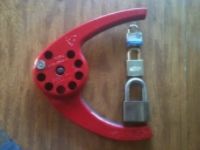


Ain't that a nice Beaver?
Always wanted to see how they worked inside, so this was a great chance to find out.
Picking this lock is easy enough to do, but the problem is you need to pick it for each quarter turn, for about 20 full revolutions. Did not feel like picking this thing 80 times, so impressioned a key. Key bitting is not shown, as there is a good chance this will be returned to service by the owner.

Once you have the key, turn it, turn it, turn it....

Then you just turn it! and turn it. and turn it...

Until the lock comes completely unthreaded from the center spindle.

Yes, unthreaded. The tailpiece of the lock is a loooong nut.

Once the lock is removed, you can lift off the lid.

Underside of the lid shows it is of Canadian manufacture. A shout out to our Canadian members!

Looking down, you can see the center spindle that the lock holds on to, two side spindles that holds a metal frame down onto the clear plastic sides and through to the bottom metal of the candy chamber. The triangular areas are where the candy is portioned for dispensing. Anybody for some... uhh... vintage Hot Tamales? (Had to stop my son from trying to eat them. Yech! How old are those things?).

These funny shaped walls are for giving the candy something to shove up against to allow it to drop into the triangular portion areas. Yes, that is some more not-exactly-fresh candy in there.

From underneath, you can see the teeth of the gear attached to the portioning part.

With the upper section removed, you can see into the lower section. The square red section is the funnel that guides the candy out of the portion area to the dispensing part where you get your yummy candy. All around that is an area for holding the money.

The back of the coin receiver/handle/drive gear (whatever it is called). Sorry I don't know the correct names for the parts. Perhaps some other members can identify them more accurately than 'Dinglehopper', 'Doohickey' and 'Thingamajigger'. (For those of you for whom English is not your first language, those three strange names I just used - 'Dinglehopper', 'Doohickey' and 'Thingamajigger' are some of the many words we use that refer to something for which we don't remember the name. You probably won't find them in your English-to-Dutch/Portuguese/Hungarian dictionary, so thought I better explain.

The mechanism at the front is removed by lifting it up.



There is an aluminum cover for the candy-channel/funnel.

that simply lifts off.

Then the dispensing cover on the front of the machine lifts out of the groove.



Leaving only the bottom of the machine, the spindle that holds the whole thing together, and the money. (Which will be going back to the owner still in the candy machine).

As for the mechanism with the handle on the front, here it is from the back. You can see the rachet mechanism, and the gear that turns the portion part.

Look at the steel under the black spring. Prior to the handle being turned...


Being turned a little bit without a coin present...

The ratchet mechanism ready for the coin to be inserted...

This is as far as it turns without a coin.

OK, now you can see a quarter in the coin slot.

The spring can not push the other piece of metal below it down with the coin present.

The quarter is now near the bottom, and you can see the ratchet is now further around the outside of the toothed area.

There is a ramp at the bottom that causes the coin to slide out of the slot and into a channel that drops into the coin bank.




Hey! As I was reviewing this post before actually posting it, realized that the quarter in the picture is for my home state of Arizona. Cool.
And as the coin reaches the bottom of the machine, we reach the end of this post. Hope some of you learned something.
Anybody for some Hot Tamales? Bet the owner won't mind the loss of the few pieces of candy.
Gordon






